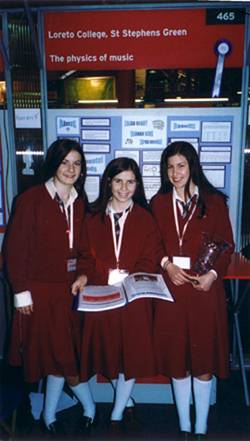| 2003 |

|
YEAR BOOK |
Loreto College, St Stephen's Green, Dublin
|
The physics of music
|

|
� Expand our basic knowledge of the physics of sound.
� Research in depth the different types of scales and how they were devised. � Discover which instruments use which scale and why. |
After the above preliminary research, we began experimenting. Initially we used the oscilloscope, but then we discovered the data-logging equipment (recording equipment on the computer that converts sound waves into graphs that can be easily analysed).
We recorded the frequencies of a scale on both the flute and violin. We then compared them to our previous calculations of frequencies. There are two main ways to create these scales:
|
� Moderate Chromatic Range, which has equal spacing, therefore making it easy to transpose.
� Natural Range, which is based on chords and is calculated by dividing the octave. |
By examining our results and gathered data, we came to the conclusion that the flute (and all fixed instruments) use the moderate chromatic range because their shape cannot be contorted or changed. Whereas a violin (and other stringed instruments), as well as vocal sounds, are free to use either scale as you can tune them. However good violinists tend to use the natural range because it is based on harmonics of the tonic/base note.
In order for us to fully understand all our new discoveries we had to research the complex mechanisms of the various instruments. We then posed the question - why does a note, e.g. 'C', sound different on the various instruments? By using the data-logger we could record and analyse graphs of the notes. We discovered Fourier analysis (a program which divided a note into its components) and, by displaying the FFT graphs, it enabled us to clearly see the overtones of the note. Overtones/ harmonics are multiples frequencies of the base note. We learned that each note sounds different because of its overtones.
We now understand much more about the world of music and physics: however there remains a lot more to be learnt.
Sophie Honohan, Ealga Beary & Hannah Kirk entered their project in the Intermediate Group Section in the Chemical, Physical and Mathematical Sciences category at the Esat BT Young Scientist & Technology Exhibition in January 2003. They won a special award sponsored by Shaw Scientific.
Their teacher was Ms Sheila Porter.
|
|